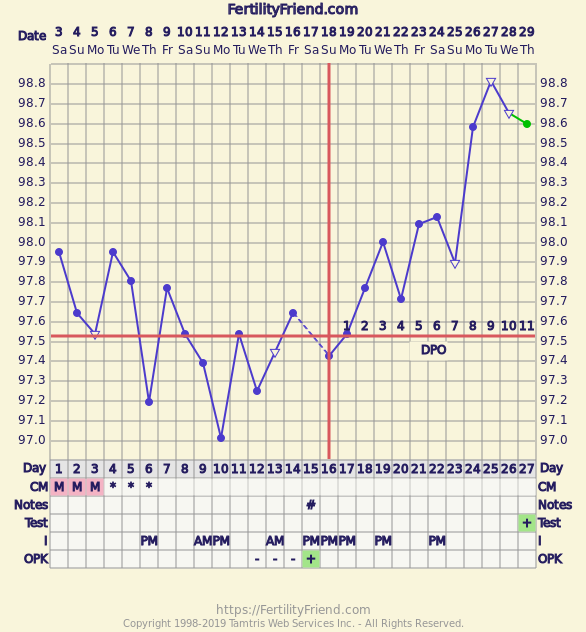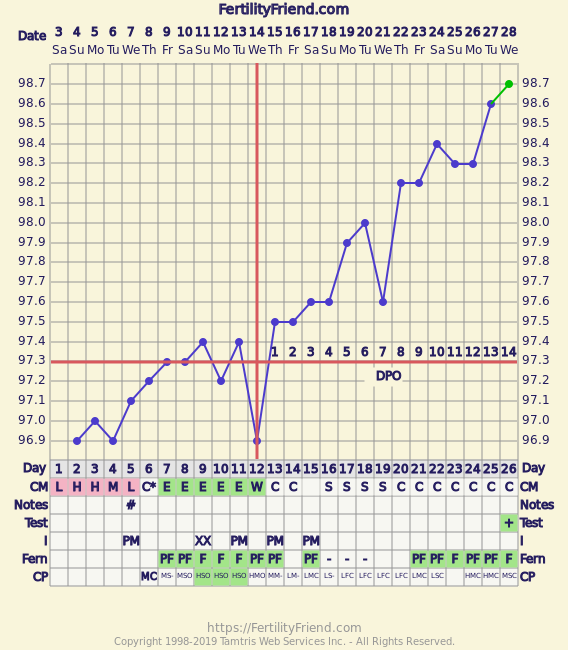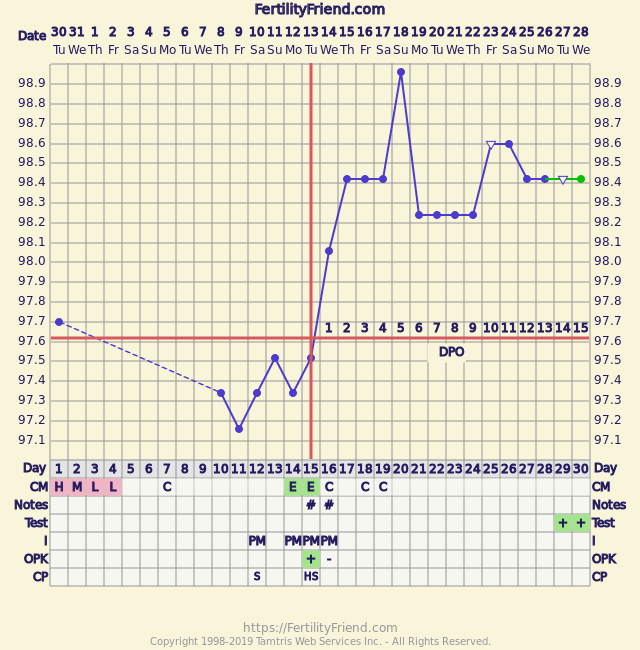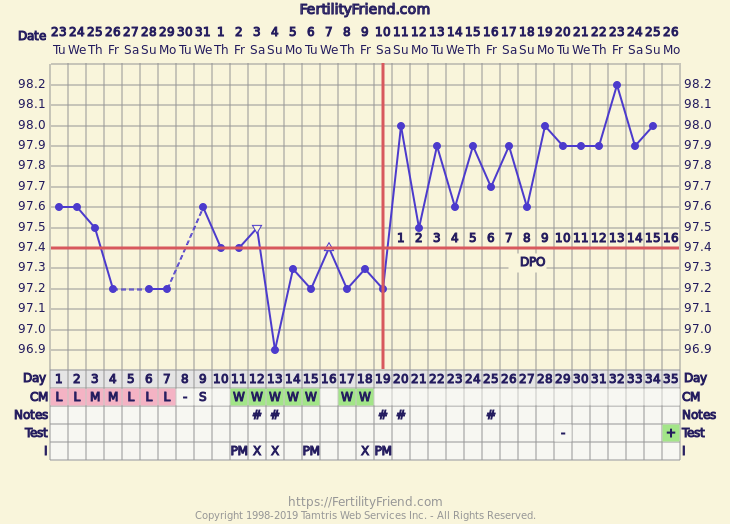Pregnancy Chart Patterns
Lesson 17
Identifying Signs of Pregnancy on your Chart
Lesson Objectives:
-
Learn how to recognize possible early pregnancy signs on your chart.
-
Learn how to assess your pregnancy chances as your cycle winds down.
Major Points in this Lesson:
-
This lesson discusses and illustrates pregnancy chart patterns.
-
Any ovulation pattern can result in pregnancy if there is well timed intercourse in the fertile phase.
-
The best thing to see on your chart when you are trying to conceive is well timed intercourse, a clear ovulation pattern and temperatures that stay high beyond your usual luteal phase length.
-
Some promising possible signs of pregnancy are: a triphasic chart pattern (shows a third higher level of temperatures), "implantation spotting" at around 7-10 days past ovulation or an "implantation dip" at around 7-10 days past ovulation. While these signs are seen with greater frequency on pregnancy charts, any of these signs can also be seen on non-pregnant charts so are not sure signs of pregnancy.
Pregnancy Patterns and Testing for Pregnancy
Pregnancy chart patterns are really a variation on ovulation patterns. Any ovulation pattern can result in pregnancy if there is intercourse in the fertile window.
The important thing to remember when you are scrutinizing your own chart for signs of pregnancy before your period is expected is this: there are no absolute signs that will indicate pregnancy with certainty, or rule it out, until you can reliably take a pregnancy test or until you see your period.
Your chart does not need to show any kind of particular ovulation pattern or post-ovulation pattern for you to be pregnant. Indeed, many women have no early signs that they are pregnant. Likewise, well-timed intercourse and a clear ovulation pattern on your chart does not always mean that you are pregnant- even when the chart looks promising. Even patterns that appear with greater frequency on pregnancy charts can sometimes be seen on non-pregnant charts.
All this uncertainty can make for an agonizing couple of weeks while you are waiting to test. If you get to 18 days past ovulation with high temperatures and no sign of your period, you are most likely pregnant. However, most people who are trying to conceive find that much too long to wait and want to know the earliest they can take a pregnancy test to find out for sure.
To add to the agony and anxiety of the wait, the effects and symptoms of the post-ovulation hormone progesterone can complicate matters further when you are hoping for pregnancy. This is because progesterone dominates the luteal phase of your cycle whether or not you are pregnant and is also present in large amounts during pregnancy. Thus, symptoms that are typically present during the second part of your cycle may also be present in early pregnancy. This makes distinguishing between early pregnancy symptoms and signs that you are about to get your period very difficult.
While pregnancy cannot be detected absolutely from your chart before a pregnancy test turns positive, there are some characteristics that many pregnancy charts share.
Some characteristics of Pregnancy Charts:
-
The intercourse pattern shows intercourse within the most fertile window (the day of ovulation and/or the two previous days).
-
Chart clearly shows ovulation.
-
Temperatures stay elevated beyond the usual luteal phase length.
-
Sometimes shows a temperature dip around 7-10 days past ovulation
-
Sometimes shows spotting when implantation is expected to occur (7-10 days past ovulation)
-
Temperatures may show a triphasic pattern (temperatures rise to a third higher level that is sustained around 7-10 days past ovulation).
-
Pregnancy test is positive (of course).
The following pregnancy charts have been selected from FertilityFriend.com's chart gallery to illustrate the variety of chart patterns that can show pregnancy.
Pregnancy 1

The chart above shows a triphasic pattern with temperatures rising to a second, higher level at 7 days past ovulation, around the time implantation is expected to take place. Intercourse is well-timed all through the fertile time and the pregnancy test is positive at 11 days past ovulation.
Pregnancy 2

The chart above shows ovulation detected on cycle day 12 with intercourse well-timed on the day before ovulation. The temperature dips at 7 days past ovulation (often called an "implantation dip" on pregnancy charts) and then temperatures continue to rise until a positive pregnancy test is recorded at 14 days past ovulation.
Pregnancy 3

The pregnancy chart above shows ovulation clearly detected for cycle day 15 with intercourse well timed on the day before ovulation and the day of ovulation. A positive pregnancy test is recorded at 14 days past ovulation. Aside from the positive pregnancy test and temperatures that stay elevated, this chart shows no particular early pregnancy signs.
Pregnancy 4

The chart above shows ovulation detected on cycle day 19 with intercourse well timed on the day before ovulation and the day of ovulation. Temperatures remain elevated after ovulation and a positive pregnancy test is recorded at 16 days past ovulation.
Though some signs may indicate an increased probability of pregnancy (such as a triphasic pattern, spotting or a temperature dip around the time of expected implantation) these signs can appear on both pregnant and non-pregnant charts and so cannot be used to determine whether you are pregnant before a pregnancy test can reliably be taken. The best things to see on a chart when you are hoping for pregnancy are: a clear ovulation pattern, well-timed intercourse during the fertile time and temperatures that stay elevated beyond the usual luteal phase length.
One of the best things about charting your fertility signs is that you know when you can reliably take a pregnancy test and whether or not you have a chance to be pregnant. Though it is so hard to resist taking an early pregnancy test when you are trying to conceive, waiting for a reliable test date or avoiding testing if you did not have intercourse in your fertile time can save money and reduce anxiety and disappointment.
When you chart your fertility signs you can see if intercourse was well-timed during your fertile phase. Assuming that intercourse was well-timed, a pregnancy test can reliably be taken once you are a day past your usual luteal phase length. Once you have enough cycle data entered on FertilityFriend.com and your luteal phase length is known, FertilityFriend.com will indicate a reliable test date for you based on this information. For your first cycle charting, before your usual luteal phase length is known, FertilityFriend.com will offer a more conservative, later test date.
Further reading:
Next Lesson: Advanced Conception Tools to Maximize your Conception Chances
Note: Please check this lesson within the app to access the lesson quiz.

